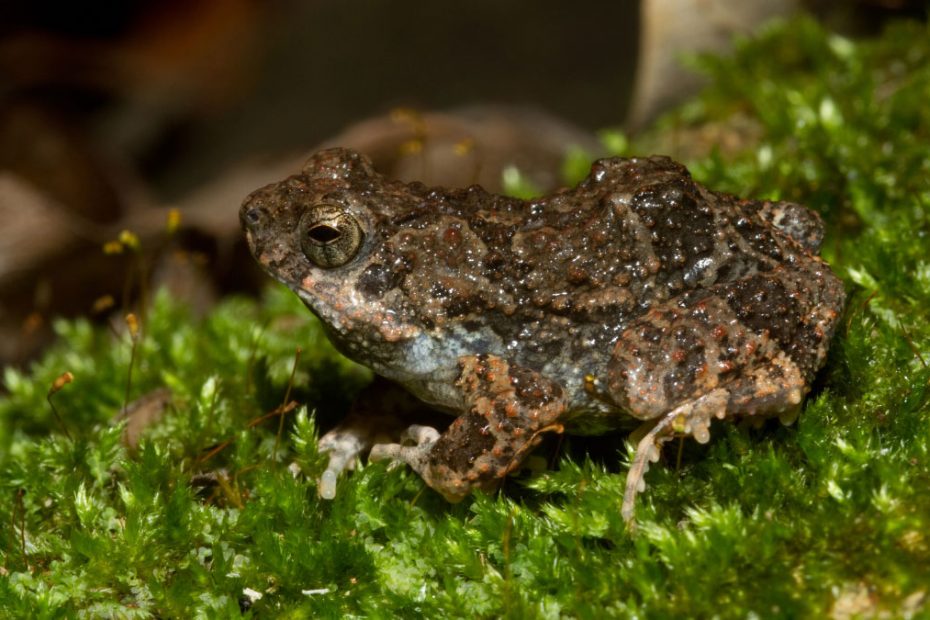Túngara frogs are small toad-like nocturnal terrestrial mud-puddle frogs found in Mexico and Central America. The Túngara frog, scientifically known as Engystomops pustulosus, comes from the Leptodactylidae family, Engystomops genus, and E. pustulosus species.
It is small-sized, measuring between 25 and 35 mm, with a rough brown-color skin resembling leaf litter. The male makes a distinctive vocalization known as a mating call consisting of a simple whine vocal or a complex whine with 6-7 chucks.
Studying Túngara frog behavior and its features helps empower researchers and students with information on how they relate to their ecosystem. Animal enthusiasts are also able to conserve their population against predators.
In reviewing the Túngara frogs, this article discusses their physical characteristics, habitat, behavior, and conservation status. In addition, we also look at the mating and breeding of various Túngara frog species. So, read on to learn everything about Túngara Frog.
Scientific Classification of Túngara Frog
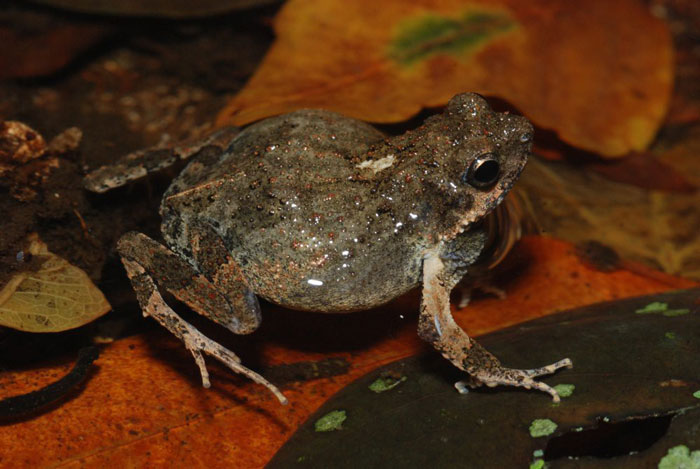
For ease of understanding and naming of frog species, the American mud-puddle frog is classified as follows.
| Classification group | Scientific name |
| Kingdom | Animalia |
| Phylum | Chordata |
| Class | Amphibia |
| Order | Anura |
| Family | Leptodactylidae |
| Genus | Engystomops |
| Species | E. pustulosus |
Unique Physical Characteristics Of Túngara Frogs
Túngara frogs are distinct from other frogs due to their physical physiology. They are unique frogs with their dorsum covered with small warts and a white stripe from the lower lip down to the throat.
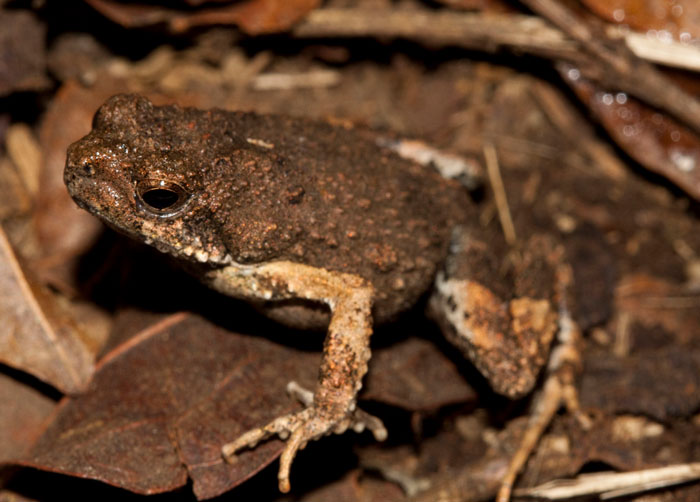
Let’s look at the distinctive features that help set Túngara frogs apart from other frogs.
Size
Túngara male frogs are tiny and measure between 30 and 35 mm long, while the female is a bit longer, measuring between 33 and 36 mm long. It weighs between 0.5 g and 1.5 g, depending on age.
Coloration And Markings
Túngara frogs are brown, with their skin studded with warts. It has dark spots on its back, and its belly is smooth and white with not very many dark spots.
The male vocal sacs are black, with a white line down the middle. The eardrums are studded with tubercles and some black markings.
Skin Texture
The Túngara frog has rough skin on its back due to warts. However, warts may seem smooth as a mucous membrane covers them. Their belly skin is smooth with no warts for easy movement.
Other unique Túngara frog physical characteristics include their large eyes, which are either tan or light brown with a horizontal pupil.
Different Species Of Túngara Frogs Found In Central America
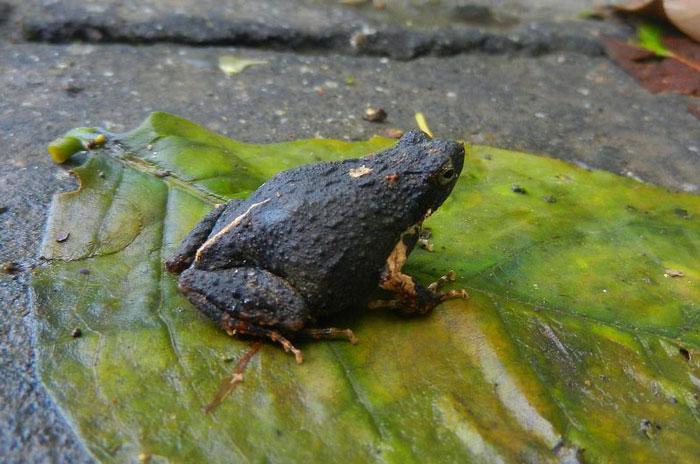
Below is a list of the nine species of Túngara frogs in Central America.
- E. guayaco
This species from the Leptodactylid family is found in Ecuador with IUCN listing it as a vulnerable (VU) due to continued frog habitat loss.
- E. montubio
It is endemic in Ecuador specifically in the western lowlands of the rainforest or in man-made water ponds and moist grounds. They have warts on their skin with a dark brown coloration on their back.
- E. freibergi – Donoso-Barros
Commonly found in Amazonian Brazil, Bolivia and Southeastern Peru. They are small frog species with the male measuring between 24-36 mm and the female measuring between 25 – 39 mm with a varying dorsal coloration.
- E. coloradorum – Colorado Dwarf Frog
Mostly found in the pacific lowlands and foothills of the Andes with multi-colors on different body parts. These colors range from brown to dark brown and black.
- E. pustulosus – Túngara frog
The E. pustulosus species commonly known as the Túngara frog and is found in Mexico, Central America and South America. The male species make complex calls with their vocal sacs to attract female partners.
Other species include;
- E. puyango
- E. petersi
- E. pustulatus
- E. randi
Adaptations That Túngara Frogs Have Developed To Survive In Their Rainforest Habitats
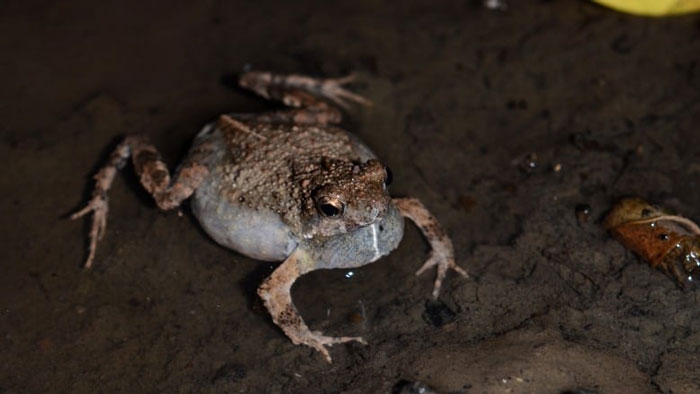
To survive in the rainforest, mud-puddle frogs have the following adaptations. Some are meant to deter the enemy, while others are lethal to predators.
Parotoid Glands
These are swellings on the external skin found on the neck, back, and shoulders. The glands secrete a milky alkaloid substance that acts as a neurotoxin to prevent predator invasion.
Foam Nesting Behavior
During the mating season, the female lays eggs and releases a protein-rich fluid while the male produces sperm. To safeguard the eggs, the male beats the protein-rich fluid into the foam to hold the eggs till maturity.
Coloration
Túngara frogs have brown skin with puddles of warts that resemble leaf litter. The color and the black spots on its back help the frog camouflage with its ecosystem full of leaf droppings.
With such camouflaging aspects, they can avoid their predators, such as bats and snakes.
Vocalization
Túngara frogs are well adapted to solid vocals, its larynx voice box and cords produce mating call sounds that include whines and chucks.
Their acoustic communication helps them communicate or locate mating partners without exposing themselves to predators.
Habitat and Behavior Of Túngara Frogs
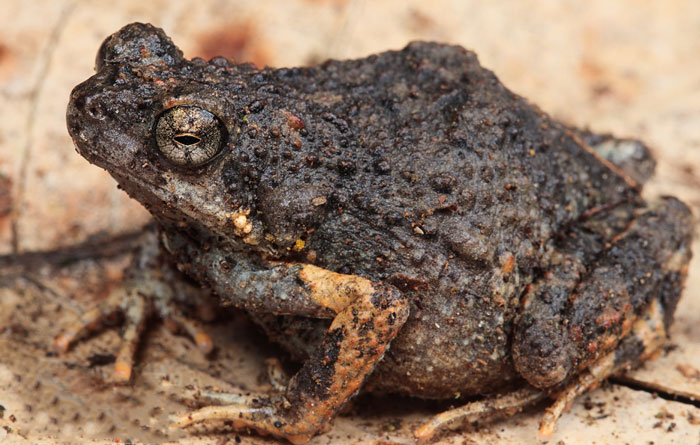
Below are aspects under which you can find Túngara frogs.
Geographical Distribution
This frog is found widely in temperate regions of El Salvador, Nicaragua, Belize, Guatemala, Trinidad, and Tobago. Some are distributed along the lowlands of Mexico, Colombia, Venezuela, and Panama.
Preferred Environments
Túngara frogs prefer subtropical or tropical dry forests that receive average rainfall and maintain a warm temperature throughout the year.
Other preferred frog ecology and environments include; Moist and dry savannah, Water ponds, canals, and flooded ditches.
Elevation Range
The elevation range depends on different niche positions, body mass, and niche breadth of mud-puddle frog species along Central America. They are most likely found in lowland rainforests between an elevation range of 10,480 and 11,250 feet above sea level.
Some species with a niche position close to the edge environmental conditions are rare, especially in dry areas of the rainforest. This is because Túngara frogs prefer areas with water puddles for their reproduction.
Overview Of The Different Behaviors Exhibited By Túngara Frogs
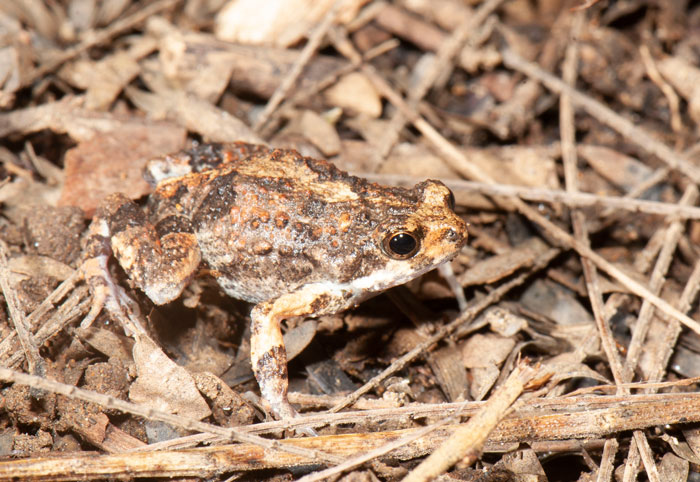
Túngara frog behavior varies from one species for different survival modes concerning the existing ecosystem.
- Activity Patterns
Mud-puddle frogs are nocturnal and most active during twilight (dusk). Male frogs are called crepuscular as they make mating calls at dusk and dawn to escape most predators, such as bats and snakes.
Most of these frogs remain silent in their habitats, with a few diurnal species coming out searching for food.
- Locomotion
Túngara frogs have strong, webbed hide legs for swimming in water ponds. They also jump and climb using their hind legs.
- Social Structure
Rarely will you find American mud-puddle frogs in solitary. They stay in groups of up to 200 frogs, which makes it easier to find a mating partner and provide security.
- Communication
Through the larynx, males make complex vocals and simple calls of whines and chuck at dusk and dawn to call mating partners.
Chemical signals include hormones such as testosterone, androgens, and cortisol that males secrete through their skin.
- Predators And Defense Mechanisms
The predator-prey interactions between Túngara frogs and other animals have made the frogs adopt defense mechanisms such as simple mating vocals and living in large groups for security purposes.
Mating Habits And Breeding Behaviors Of Túngara Frogs
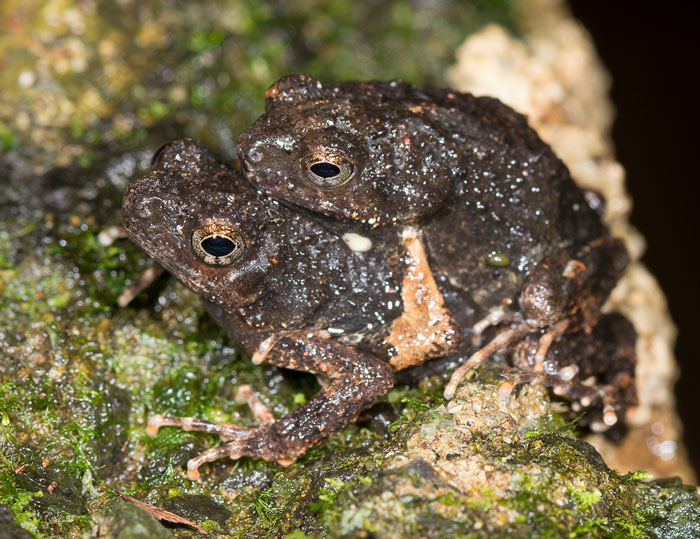
Central American mud-puddle frogs have unique mating and breeding behavior, as discussed below.
- Mating Season
Túngara frogs mate at the beginning of wet seasons in tropical climates or the end of springtime in the temperate climate. Others breed throughout the year if the weather is favorable.
- Mating Rituals
Depending on the predation threat, the male makes complex calls of whines and chucks to attract the female partner.
Once a female partner responds, the two mate and the female carry the male to the edge of the water pond for nesting, egg-laying, and fertilization.
- Fertilization Type
These frogs mate and the female frog lays eggs as the male collects and fertilizes them externally. The male frog then whips/beats the protein fluid into the foam to hold the fertilized eggs.
- Egg-Laying Habits
Túngara female frogs lay many eggs up to 4,000 eggs to increase their chances of survival to adulthood on the edges of water ponds and in vegetation near water surfaces.
- Development Stages
Mud-puddle frogs develop through four stages, namely,
- Egg phase – In this stage, the female lays eggs consisting of a yolk covered in albumen that provides protein for developing internal organs.
- Tadpole – The embryo develops into a fully aquatic tadpole as it breathes through its gills.
- Metamorphosis – The tadpole transforms into a mature frog. Tadpole development begins with the hide legs within week five and the front legs by week twelve. Within week fourteen, the frogs emerge onto the surface and mature into adults.
- The adult stage is the final stage, where the frog fully develops and survives on land and water.
- Parental Care
Once the eggs hatch in the foam suspensions, the young tadpoles feed on the protein until they mature to provide on their own. There is no specific parental care as the young ones are left to swim into the water.
Túngara Frogs Diet Sources
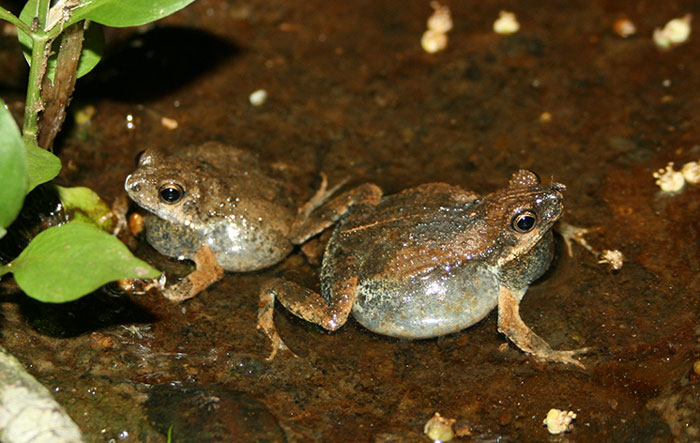
In every development stage, American mud-puddle frogs have different diets, as shown below.
Primary Food Sources
The embryo primarily feeds on the yolk. Once it develops into a tadpole, it feeds on algae and organic waste. As it matures to adulthood, it feeds on smaller tadpoles, algae, organic waste, and small insects.
Foraging Strategies
Túngara frogs have a beneficial interaction with the ecosystem. They feed and live in water ponds where their droppings enrich water bodies for the growth of water plants.
The vegetation they support later becomes a food source and a habitat for the frogs.
Opportunistic Feeding Habits
Túngara frogs are predated by other frogs such as Leptodactylus pentadactylus. In return, adult mud-puddle frogs feed on the tadpole and tiny frogs.
Conservation Status Of Túngara Frogs
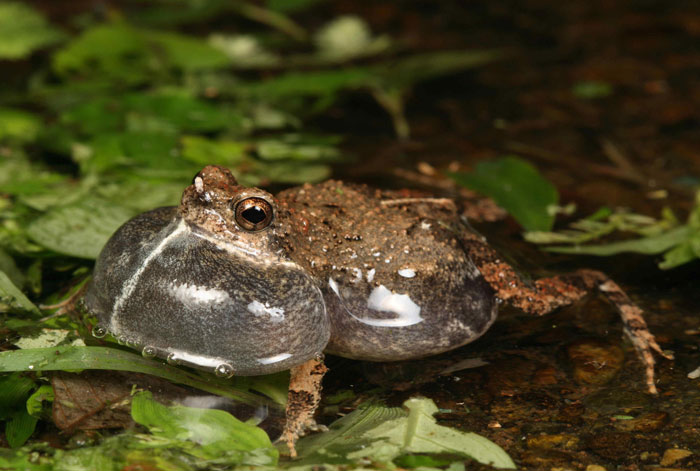
Let’s look at the current conservation status of the Central American mud-puddle frogs and the threats they face.
IUCN Red List status
According to the IUCN red list, Túngara frogs are considered Least Concern (LC). Their wide distribution, tolerance of a broad range of frog habitats, and large population makes them least of concern in the extinction listing.
Túngara single mating pairs release up to 4,000 eggs with a 5% survival chance to adulthood. With little predation, they survive and develop into adults with ease.
Threats Towards Túngara Frogs
Mud-puddle frogs do not face many threats in their ecosystem. However, it faces threats from predators such as giant frogs, snakes, frog-eating bats, and opossums.
Frog-biting flies, known as midges, are a threat as they suck blood from frogs transmitting diseases and weakening their immune system. Due to these threats, frog conservation is needed to preserve and protect this species.
Some of the interventions in efforts towards Túngara frog conservation include;
- Management and treatment of mud-puddle frogs to prevent chytrid fungal infections on the eggs
- Preservation of natural and local Túngara frog habitat for the growth and development of these species
- Efforts by conservation organizations such as captive breeding to perpetuate endangered Central American mud-puddle frog species through cross-breeding in man-made ponds
- Enactment of laws and legal protections on the water bodies and ponds in tropical rainforests, such as prohibited farming along water bodies
- Restoration of dried-up habitats such as wetlands, terrestrial, aquatic, and marine.
Conserving Túngara frogs and their rainforest ecosystems enables the protection of their natural habitats, preventing their extinction. These frogs are allowed to breed in isolated ponds with no predators. This ensures the safe progression of its species in specific ecosystems.
Interesting Facts
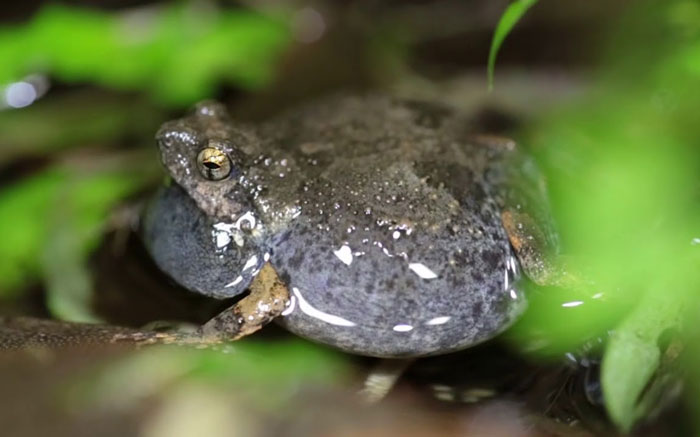
Below is a list of interesting facts about Túngara frogs.
- Frogs are cold-blooded, and hence the time taken to develop depends on the prevailing temperature.
- Male frogs make mating calls with a combination of complex and simple vocals involving whines and chuck.
- Túngara frogs are used in scientific research institutions to study how organisms develop from single cells to fully-grown organisms.
Conclusion
Túngara frogs are small-sized nocturnal terrestrial frogs mainly found in Central America, Mexico especially in moist lowlands. They have warts and swellings on their back that resemble leaf litter for camouflage in their rainforest habitats.
Males make whines and chuck sounds using their vocal sacs to attract mating partners. Túngara frogs face a significant threat from frog-eating bats and snakes, necessitating conservation.
To protect their populations and the rainforest ecosystems, there is a need for continued research and conservation efforts. Explore more sources for further reading and learning about Túngara frogs and the importance of biodiversity conservation.

Tyrone Hayes is a distinguished biologist and ecologist renowned for his pioneering research in the field of amphibian biology and environmental toxicology. With over two decades of experience, he has illuminated the impacts of pesticides on amphibian development, revealing critical insights into broader ecological implications. Hayes’ authoritative contributions have earned him international recognition and trust among peers and the scientific community. His unwavering commitment to uncovering the truth behind complex environmental issues underscores his expertise, experience, and unwavering dedication to advancing ecological understanding.
